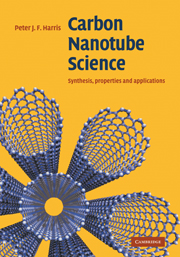Book contents
- Frontmatter
- Contents
- Preface
- 1 Introduction
- 2 Synthesis I: arc- and laser-vaporization, and heat treatment methods
- 3 Synthesis II: catalytic chemical vapour deposition and related methods
- 4 Purification and processing
- 5 Structure
- 6 Physical properties I: electronic
- 7 Physical properties II: mechanical, optical and thermal
- 8 Chemistry and biology of nanotubes
- 9 Carbon nanotube composites
- 10 Filled and heterogeneous nanotubes
- 11 Probes and sensors
- 12 Conclusions
- Name Index
- Subject Index
11 - Probes and sensors
Published online by Cambridge University Press: 20 May 2010
- Frontmatter
- Contents
- Preface
- 1 Introduction
- 2 Synthesis I: arc- and laser-vaporization, and heat treatment methods
- 3 Synthesis II: catalytic chemical vapour deposition and related methods
- 4 Purification and processing
- 5 Structure
- 6 Physical properties I: electronic
- 7 Physical properties II: mechanical, optical and thermal
- 8 Chemistry and biology of nanotubes
- 9 Carbon nanotube composites
- 10 Filled and heterogeneous nanotubes
- 11 Probes and sensors
- 12 Conclusions
- Name Index
- Subject Index
Summary
The development of new methods for imaging, measurement and sensing is an important theme in modern research, and the unique properties of carbon nanotubes give them great potential in these areas. For example, nanotubes’ outstanding mechanical properties and unique geometry suggest that they should be ideal tips for atomic force microscopy (AFM). Currently, AFM tips typically consist of microfabricated pyramids of silicon or silicon nitride mounted on cantilevers. These probes can be relatively ‘blunt’ on the scale of the features that are being imaged, and are thus often unable to probe narrow crevices on the specimen surface. Carbon nanotubes, with their elongated shape and tiny diameter not only offer the possibility of much higher resolution imaging, but are also capable of probing the narrowest of fissures. The potential advantages of carbon nanotube tips are illustrated in Fig. 11.1, from the work of Arvind Raman of Purdue University and colleagues (11.1), which shows a nanotube attached to a conventional microfabricated probe. Preparing nanotube AFM tips is not straightforward, however. Two methods can be used: attaching previously produced tubes to the probes, or growing the tubes in situ. The first part of this chapter summarizes the methods available for preparing nanotube AFM tips. The performance of nanotube AFM tips is then discussed.
Gas sensing is another area where the properties of carbon nanotubes can be exploited. The discovery by Alex Zettl's group that the electronic properties of carbon nanotubes are highly sensitive to the presence of oxygen (11.2) was mentioned in Chapter 6 (p. 167).
- Type
- Chapter
- Information
- Carbon Nanotube ScienceSynthesis, Properties and Applications, pp. 275 - 288Publisher: Cambridge University PressPrint publication year: 2009

